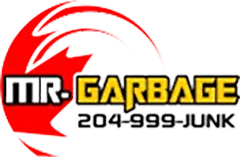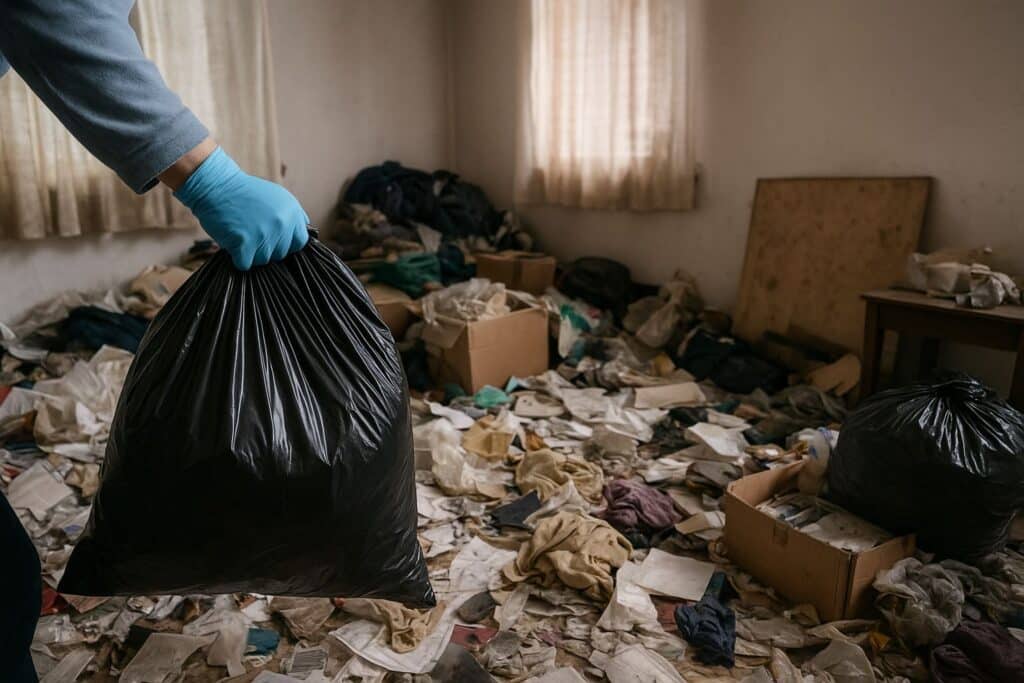Hoarding situations are delicate and often overwhelming. Whether you’re helping a loved one, a neighbour, or facing the problem yourself, knowing how hoarding cleanup services in Winnipeg work makes the path forward less intimidating. This guide explains what to expect from professional
hoarder cleanup services, how to combine cleanup with health and social supports, legal and safety considerations in Winnipeg, and practical next steps you can take today. I’ll also explain how Mr. Garbage works with families and professionals to manage discreet, respectful cleanups.
What “hoarding cleanup services” are and who needs them
Hoarding cleanup services are specialized waste-management and support services for homes where clutter and excessive accumulation prevent normal use of living space, create safety or health hazards, or threaten tenancy. These services go beyond ordinary junk removal: they include careful sorting, documentation, safe disposal, coordination with health professionals, and often emotional support for the homeowner.
People who seek help are a mix: homeowners who want to regain control of their space; families intervening for safety reasons; landlords or property managers responding to health or bylaw complaints; and clinicians seeking a partner for a therapeutic cleanup. Hoarding is linked to mental-health conditions such as hoarding disorder, obsessive-compulsive disorder, depression, and cognitive challenges, which is why cleanup teams that work closely with health professionals get the best long-term results. The Canadian Mental Health Association provides plain-language information on hoarding disorder that’s useful for families and service providers.
cmhaacrossmb.caHow hoarding cleanup services in Winnipeg work
Initial contact and compassionate assessment
A reputable hoarder cleanup service starts with a confidential phone or in-home assessment. The first meeting is about safety and trust: what are the immediate hazards (blocked exits, mould, live wiring, pests), and what are the client’s priorities? This step usually includes a walkthrough with the homeowner or family, a privacy agreement, and an outline of a plan that respects the person’s attachment to items.
Planning, partnerships, and documentation
Good cleanup teams plan carefully. This means:
- Identifying items that must be kept (documents, medications, sentimental pieces).
- Noting items that need specialist disposal (electronics, hazardous chemicals, sharps).
- Coordinating with health and social services if the homeowner is working with a clinician or caseworker.
- Agreeing on timelines and safe access for workers.
Documentation is important for landlords or tenancy cases, but it should be handled sensitively and shown only to authorised people.
Sorting, cleaning, and safe disposal
Teams use a sorting system agreed with the homeowner: keep, donate, recycle, hazardous, or trash. For safety and dignity, teams often let the homeowner make final calls on highly personal items. Items requiring special processing syringes, chemicals, large appliances with refrigerant, or electronics, are routed to appropriate processors and depots. Mr. Garbage, for example, coordinates hazardous disposal and certified recycling as part of its hoarding cleanups.
Deep cleaning, repairs, and follow-up support
After removal, a hygienic deep clean is often needed: pest control, mould remediation, and minor repairs to restore habitability. Many cleanup providers connect homeowners with community resources and support groups so the cleanout is more than a one-off event. A follow-up plan ongoing waste collection, support services, or counselling, reduces the chance of relapse.
Safety, health, and legal considerations in Winnipeg
Hoarding cleanups bring safety and legal questions. Winnipeg’s bylaw and property standards frameworks allow city staff to intervene when properties present health and safety risks. At the same time, interventions must respect privacy and mental-health needs. The City of Winnipeg enforces property and neighbourhood standards and has measures for inspections and code enforcement; local reporting or bylaw involvement sometimes triggers triage to social services. Recent city reporting also notes initiatives to triage hoarding and connect residents with supports.
City of WinnipegKey safety steps cleanup teams take
- Use personal protective equipment (PPE) and follow infection-control protocols.
- Separate and document hazardous materials for correct disposal.
- Ensure exits, smoke detectors, and utilities are safe before workers leave.
- If the homeowner is at risk, coordinate with health providers rather than leaving the person isolated.
Health partners like Winnipeg Regional Health Authority and community programs provide in-home supports that are crucial during and after cleanup. If the situation suggests hoarding disorder or other mental-health needs, linking cleanup with therapeutic care is the humane standard.
Winnipeg Regional Health AuthorityWho should be on the cleanup team?
Hoarding cleanups are safest when they include different skills:
- Professional removal crews experienced in sensitive, non-judgemental work.
- Licensed disposal and recycling partners for hazardous waste, electronics, and biohazard materials.
- Cleaning and remediation specialists for mould, pests, and deep cleaning.
- Mental-health professionals or caseworkers who can offer counselling and relapse prevention.
- Social supports or seniors’ services where needed for older adults, programs like A & O’s “This Full House” in Winnipeg show how practical supports reduce risk and help older residents stay safely at home. aosupportservices.ca
Mr. Garbage works with specialty partners and can be part of a multidisciplinary team that includes clinicians and social workers.
Choosing a hoarding cleanup service in Winnipeg
When you call a provider, ask focused questions to evaluate competence and fit:
- Do you have experience with hoarding cleanups specifically?
- How do you protect client privacy and dignity?
- What steps do you take for hazardous waste, sharps, and biohazards?
- Will you coordinate with health professionals or caseworkers?
- Can you provide references or before/after examples (with client consent)?
- What is your documentation process for landlords, insurers, or agencies?
A good provider is transparent about their process, patient with owners, and clear about safety steps. They’ll also explain when they cannot handle a specific hazard and refer you to the right specialist.
Real-world Winnipeg example
A Winnipeg case involved an older adult with significant clutter blocking rooms and causing mould concerns. The family called a local cleanup provider who worked with a public-health nurse. The team prioritized safety: clearing an egress path, removing immediate biohazard items, and arranging mould remediation. The homeowner was part of every decision; sentimental items were photographed and safely stored on request. A follow-up care plan included weekly in-home support through local senior programs and a gradual maintenance schedule. The coordinated approach reduced eviction risk and helped the homeowner stay in their home with dignity.
Programs like the City’s triage initiative and community supports help make these mixed interventions possible.
winnipegfreepress.comSensitive disposal: What cannot be mixed with common waste
Hoarding cleanups often uncover items requiring special handling:
- Medical sharps and pharmaceutical waste: need secure, licensed disposal.
- Hazardous household chemicals: solvents, pesticides, and certain cleaners must be handled by hazardous-waste processors.
- Electronic waste and batteries should be routed to certified e-waste processors.
- Asbestos, mould-contaminated materials, and structural hazards: need specialists for safe abatement.
Trusted hoarder-cleanup teams document and route these items correctly to avoid environmental or health risks.
Mr. Garbage coordinates with certified processors to ensure compliant disposal.
How to support someone through a cleanup
If you’re helping a loved one:
- Start with a conversation focused on safety and care, not shame.
- Offer choices and small wins: a cleared path to a chair or the kitchen is a big change.
- Work with professionals who use non-judgmental language and allow the person time to decide.
- Avoid surprise removals of sentimental items; involve the person and document removals.
- Ask for referrals to local supports (WRHA, CMHA chapters, or community senior programs).
These steps build trust and make long-term maintenance more likely. Mental-health professionals emphasize gradual, collaborative approaches over forced, single-day cleanouts whenever possible.
cmhaacrossmb.caWhy professional hoarding cleanup is different from standard junk removal
Hoarding cleanups are different because they combine removal with mental-health sensitivity, documentation, and specialist disposal. Standard junk removal crews may lack the training to handle biohazards, to work through sentimental disputes, or to coordinate with social services and clinicians. Choose a company with explicit hoarding experience, a written confidentiality policy, and partnerships with remediation and health professionals.
Mr. Garbage provides discreet, documented hoarding cleanups and coordinates with health and social services on request, blending the practical logistics with the human-centered approach families need.
Aftercare: preventing relapse and maintaining a safe home
A cleanup is only the first step. Effective aftercare includes:
- Regular check-ins or scheduled maintenance pickups.
- Linking the homeowner with therapy or support groups knowledgeable about the hoarding disorder.
- Practical home supports (shopping help, housekeeping, home-care visits) that reduce stressors.
- Environmental changes, like better storage systems and clear labelling.
A & O’s “This Full House” and similar programs highlight how tailored supports for older adults reduce risk and help maintain outcomes after cleanup. Community programs combined with scheduled waste services keep homes safe over time.
aosupportservices.caHow Mr. Garbage approaches hoarding cleanup services in Winnipeg
Mr. Garbage’s hoarding service is built on three principles:
- Dignity: clients are treated with respect at every step.
- Safety: hazardous items are handled by certified processors, and documentation is maintained.
- Coordination: Mr. Garbage works with clinicians, landlords, and community supports to deliver a plan that lasts.
Their teams are trained to separate sentiments from hazards, to photograph and inventory items when requested, and to provide secure storage or donation routing for salvageable belongings. When a cleanup reveals health issues, Mr. Garbage helps connect homeowners with local supports so the cleanout is part of a recovery plan, not just a one-off tidy. For families and property managers, Mr. Garbage provides clear documentation and certified disposal records when needed.
Conclusion
Hoarding cleanup services in Winnipeg are a careful mix of practical removal, health-aware support, and sensitive, person-centred care. If you’re facing a hoarding situation, start with a compassionate assessment, involve health or social services where possible, and choose a specialist cleanup team that coordinates safe disposal, remediation, and aftercare. For homeowners and families who need discreet, professional help, Mr. Garbage offers experienced hoarder cleanup services and works with local health partners and certified disposal facilities to make sure the job is safe, respectful, and lasting.
Need help or advice about a hoarding cleanup in Winnipeg? Contact
Mr. Garbage for a confidential assessment and a coordinated plan that respects privacy and safety. We’ll connect you with health supports and handle removal, sorting, and certified disposal with care.
Frequently Asked Questions (FAQs)
Q1: What do hoarding cleanup services include?
A1: Hoarding cleanup services typically include a confidential assessment, sorting and inventorying, specialized disposal (hazardous and electronic materials), deep cleaning and remediation, coordination with health or social services, and follow-up support to prevent relapse.
Q2: How do I find a compassionate hoarding cleanup service in Winnipeg?
A2: Look for providers with specific hoarding experience, confidentiality policies, references, and partnerships with health or remediation specialists. Ask about their approach to sentimental items and hazardous materials handling.
Q3: Will city bylaws force a cleanup?
A3: The City of Winnipeg enforces property and neighbourhood standards when safety or health risks are present. Often, the city attempts triage and referrals to community supports before pursuing enforcement; working with a cleanup team and health providers can produce the best outcomes.
Q4: Are hoarding cleanups safe for seniors and people with health conditions?
A4: When coordinated with health professionals and using trained crews, hoarding cleanups can be safe for seniors and people with health conditions. Home health services, caseworkers, and community programs often provide support during and after the cleanup.
Q5: What happens to items removed during a hoarding cleanup?
A5: Items are sorted according to the plan agreed with the homeowner: kept, donated, recycled, sent to certified processors for hazardous materials, or disposed of. Reputable teams document removals and can arrange secure storage or donation routing for salvageable items.

